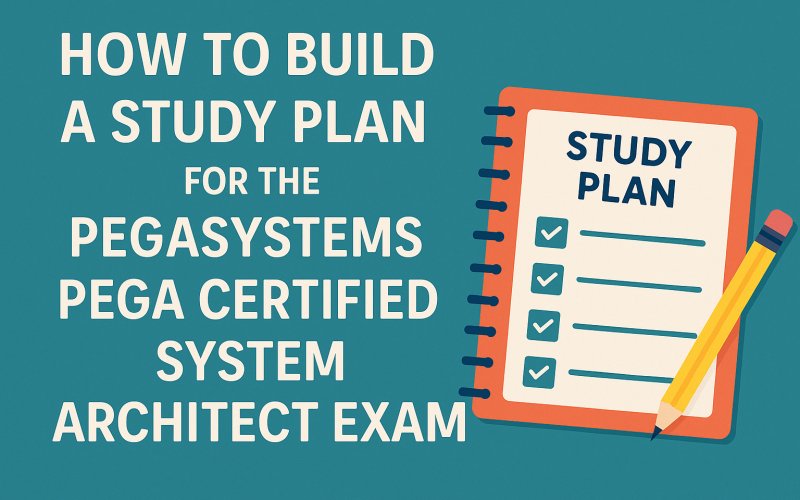Preparing for the Pegasystems Pega Certified System Architect Exam is a crucial step in launching or advancing your career in business process management and application development using Pega technology. As one of the most sought-after certifications for developers and IT professionals, success in this exam requires a well-structured and efficient study plan.
In this guide, we’ll walk you through how to build an effective study plan that not only fits into your schedule but also enhances your retention and understanding of Pega’s core principles. Whether you’re a working professional or a full-time student, this plan will help you stay on track and boost your confidence for exam day.
Understand the Exam Structure and Objectives
Before diving into the preparation, it’s essential to understand what the exam entails:
- Exam Duration: 90 minutes
- Question Format: Multiple choice
- Number of Questions: Approximately 60
- Passing Score: Around 65%-70% (subject to change)
The Pegasystems Pega Certified System Architect Exam tests your knowledge in areas such as:
- Application development on the Pega Platform
- Case management and business rules
- Data modeling
- User interface (UI) design
- Decision design
- Debugging and deployment
Knowing these domains helps you identify the areas to concentrate on and allocate your study time accordingly.
Step 1: Assess Your Current Knowledge
Start by evaluating your existing knowledge of the Pega Platform. This can be done through:
- Taking a free practice test
- Reviewing your experience with Pega if you’ve used it at work
- Reading the official exam blueprint from Pegasystems
Understanding your baseline will help you prioritize areas that require more attention and avoid spending unnecessary time on topics you already know.
Step 2: Set Clear, Achievable Goals
Having realistic goals ensures that your study sessions remain productive. Consider setting:
- Daily Goals: Topics to cover or practice questions to complete
- Weekly Goals: Completing modules or mock exams
- Long-Term Goals: Be exam-ready in 6-8 weeks
Use SMART criteria (Specific, Measurable, Achievable, Relevant, Time-bound) to frame your goals.
Step 3: Choose the Right Study Materials
Choosing high-quality, updated study materials is critical. Use a mix of resources:
- Pega Academy: Official learning platform with comprehensive courses
- Online Forums and Communities: Engage with peers and experts
- Books and eBooks: Explore deeper theoretical insights
- Practice Tests: Get used to the exam format and timing
Step 4: Build a Study Schedule
Now that you have goals and resources, build a schedule tailored to your lifestyle. Here’s a sample 6-week plan:
Week 1: Introduction to Pega Platform
- Understand Pega Platform architecture
- Explore case lifecycle management
- Use Pega Academy to complete foundational modules
Week 2: Data and Case Management
- Study data modeling and case types
- Learn about properties, pages, and data transforms
- Do hands-on exercises in Pega’s personal edition
Week 3: UI Design and Business Logic
- Practice UI form creation, layouts, and dynamic UI
- Dive into decision tables and decision trees
- Start practicing questions related to these topics
Week 4: Integration and Deployment
- Learn about integrations (Connectors and Services)
- Understand versioning and deployment methodologies
- Take a short mock test to evaluate your progress
Week 5: Debugging and Performance Tuning
- Explore Tracer, Clipboard, and Performance Analyzer (PAL)
- Review common troubleshooting strategies
- Focus on scenario-based questions
Week 6: Final Review and Practice Exams
- Take full-length practice exams
- Revisit weak areas identified in mock tests
- Revise with flashcards or summary notes
Step 5: Use Active Learning Techniques
Passively reading through material isn’t enough. Employ active learning techniques like:
- Flashcards: For memorizing key concepts
- Mind Mapping: Visualize complex processes
- Teaching Others: Explaining a topic helps reinforce your understanding
- Mock Exams: Simulate real exam conditions to reduce test anxiety
Step 6: Track Your Progress and Adjust
Use a tracker (spreadsheet or app) to monitor your daily and weekly progress. If you find that certain topics are taking more time, adjust your schedule accordingly. Flexibility is key to staying motivated and productive.
Step 7: Take Care of Yourself
Mental and physical well-being are essential to successful exam preparation. Remember to:
- Sleep well and maintain a consistent routine
- Take regular breaks to avoid burnout
- Eat nutritious food and stay hydrated
- Include some form of physical activity daily
Why Choose Certboosters for Exam Preparation?
When it comes to preparing for the Pegasystems Pega Certified System Architect Exam, choosing the right support system can make all the difference. That’s where Certboosters come in. Certboosters provides expertly curated practice questions, real-time exam simulations, and detailed explanations for every answer. With a focus on exam accuracy and learner satisfaction, Certboosters has helped countless professionals achieve certification success on their first attempt.
Their user-friendly interface and adaptive learning modules make it easy to track your progress and focus on your weak areas. Whether you’re new to Pega or brushing up on your skills, Certboosters offers the right tools and guidance to accelerate your learning and boost your confidence.
Final Tips for Exam Day
- Arrive early and ensure your test environment is calm
- Read each question carefully before answering
- Use the process of elimination to handle difficult questions
- Manage your time effectively—don’t dwell too long on one question
Conclusion
Building a study plan for the Pegasystems Pega Certified System Architect Exam doesn’t have to be overwhelming. With structured goals, quality materials, and consistent effort, you can prepare efficiently and confidently. Remember to track your progress, stay flexible, and make use of tools like mock exams and flashcards.
And if you want to supercharge your preparation, don’t hesitate to explore the offerings from Certboosters. The right preparation partner can be your biggest advantage in acing the exam.












